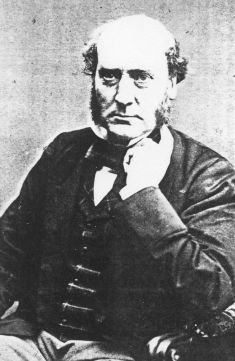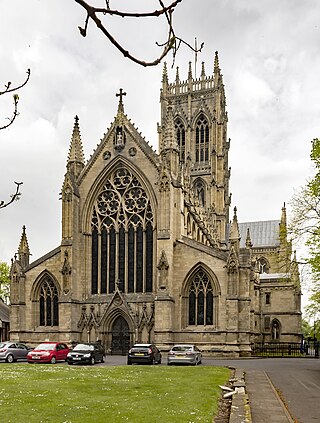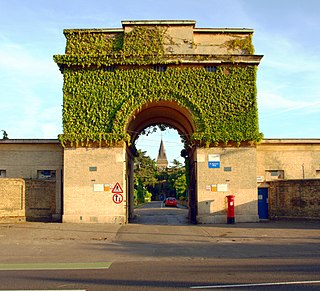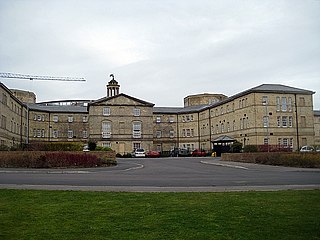
Sir George Gilbert Scott, largely known as Sir Gilbert Scott, was a prolific English Gothic Revival architect, chiefly associated with the design, building and renovation of churches and cathedrals, although he started his career as a leading designer of workhouses. Over 800 buildings were designed or altered by him.

Wakefield is a cathedral city in West Yorkshire, England located on the River Calder. The city had a population of 109,766 in the 2021 census, up from 99,251 in the 2011 census. The city is the administrative centre of the wider Metropolitan Borough of Wakefield, which had a 2022 population of 357,729, the 26th most populous district in England. It is part of the West Yorkshire Built-up Area and the Yorkshire and The Humber region.

Emma Gwynedd Mary Chambers was an English actress. She played Alice Tinker in the BBC comedy The Vicar of Dibley and Honey Thacker in the film Notting Hill (1999).
The Yorkshire Evening Post is a daily evening publication published by Yorkshire Post Newspapers in Leeds, West Yorkshire, England. The paper provides a regional slant on the day's news, and traditionally provides close reporting on Leeds United and Leeds Rhinos as well as the Yorkshire County Cricket Club team.

High Royds Hospital is a former psychiatric hospital south of the village of Menston, West Yorkshire, England. The hospital, which opened in 1888, closed in 2003 and the site has since been developed for residential use.

Doncaster Minster, formally the Minster and Parish Church of St George, is the Anglican minster church of Doncaster, South Yorkshire, England. It is a grade I listed building and was designed by architect designer George Gilbert Scott. The church was built in 1854–1858 to replace an earlier building destroyed by fire. It is an active place of worship and has a Schulze organ, a ring of eight bells, and a celebrated clock by Dent. The church is one of two parish churches to have minster status in South Yorkshire. The other is the minster church of Rotherham.

St Bernard's Hospital, also known as Hanwell Insane Asylum and the Hanwell Pauper and Lunatic Asylum, was an asylum built for the pauper insane, opening as the First Middlesex County Asylum in 1831. Some of the original buildings are now part of the headquarters for the West London Mental Health NHS Trust (WLMHT).

Sir William Charles Ellis was the superintendent of the West Riding Pauper Lunatic Asylum. His ideas on the treatment of mental illness became widely influential.

Ponden Hall is a farmhouse near Stanbury in West Yorkshire, England. It is famous for reputedly being the inspiration for Thrushcross Grange, the home of the Linton family, Edgar, Isabella, and Cathy, in Emily Brontë's novel Wuthering Heights since Bronte was a frequent visitor. However, it does not match the description given in the novel and is closer in size and appearance to the farmhouse of Wuthering Heights itself.

West Ryder Pauper Lunatic Asylum is the third studio album by British indie rock band Kasabian, which was released on 5 June 2009. It was the band's first album not to feature Christopher Karloff, the band's lead guitarist and songwriter who departed during the writing stages of Empire (2006). Rhythm guitarist Sergio Pizzorno became lead songwriter and co-producer for the band. It is also their first album to feature guitar contributions from Tim Carter, who would become the band's touring guitarist in 2013 and a full-fledged member of the band in 2021.

The Stanley Royd Hospital, earlier named the West Riding Pauper Lunatic Asylum, was a mental health facility in Wakefield, West Yorkshire. It was managed by the Wakefield and Pontefract Community Health NHS Trust.

The lunatic asylum, insane asylum or mental asylum was an institution where people with mental illness were confined. It was an early precursor of the modern psychiatric hospital.

The Ven Folliott George Sandford was the inaugural Archdeacon of Doncaster.

Theresa Garnett was a British suffragette. She was a serial protester who sometimes went by the name 'Annie O'Sullivan', was jailed and then still refused to cooperate. She assaulted Winston Churchill while carrying a whip. She retired from her militancy after the suffragette movement decided to commit arson as part of its protests. She was honorary editor of a women's right's magazine in 1960.

Outwood Academy Adwick is a mixed secondary school and sixth form with academy status located in Woodlands, South Yorkshire, England. It has a comprehensive admissions policy, with 1,080 pupils on roll as of 2024.

This is an unusual surname that was more or less restricted to West Riding of Yorkshire until the late 19th century. All living people with this surname are descended from Samuel Eamonson, who was born in approx. 1788 in Wakefield and died in 1867. He married Ann Kirk (1791-1884). Among their seven, children, their sons Joseph Eamonson (1823-1870) and James Eamonson (1828-1899) were the only ones to pass on the surname Eamonson to the next generation. Joseph and James were both born in Wakefield and became stonemasons. Study of this family thus constitutes a one-name study.
Henry Devine was a British physician and psychiatrist.

Storthes Hall Hospital was a mental health facility at Storthes Hall, Huddersfield, West Yorkshire, England. Founded in 1904, it expanded to over 3,000 patients during the Second World War. After the introduction of Care in the Community in the early 1980s, the hospital went into a period of decline and closed in 1992.

Hilda Annetta Walker FRSA was an English sculptor, and a painter of landscapes, seascapes and horses, flourishing between 1902 and 1958. She was a war artist painting in England during the First and Second World Wars, and described as "escapist". Some of her early work was the production of oilette postcard paintings for Raphael Tuck & Sons, of firemen and horses. She was born in Mirfield, Yorkshire, England, to a family of blanket manufacturers who had the means to foster her art education. She grew up in the Protestant work ethic of Congregationalism, and attended Leeds College of Art, where she studied under William Gilbert Foster of the Staithes group and William Charles Holland King, sculptor of Dover Marine War Memorial. She signed her works "Hilda Walker" or sometimes "Hilda A. Walker".

Emily Wardman was a British collector and founder of a private museum of social history, now part of the collections of Leeds Museums and Galleries.


















